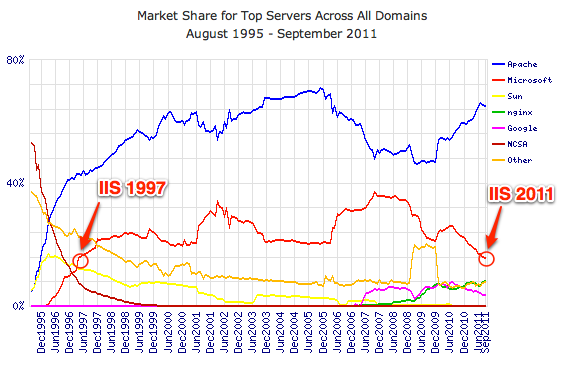 Apache has been the most widely used web server on the Internet since the early days of the Web. It still is. The second-most popular web server has been, and still is, Microsoft’s Internet Information Server, IIS. But Microsoft’s web server is now losing ground.
Apache has been the most widely used web server on the Internet since the early days of the Web. It still is. The second-most popular web server has been, and still is, Microsoft’s Internet Information Server, IIS. But Microsoft’s web server is now losing ground.
It wasn’t always like this. For quite some time, IIS was gaining ground on Apache, but the tide changed in 2007. Since then Apache has recovered much of its previous dominance, reaching a 65% market share, while the market share for IIS has dwindled below 16%, less than half of what it used to be. That’s a pretty steep drop, bringing the IIS market share back to what it was in 1997, 14 years ago.
This chart from Netcraft tells the story. We added the IIS pointers to make it easier for you to see what we’re talking about:

Netcraft has been tracking web server usage for a long time, and releases a new report every month. They’re helpful enough to include a historical chart with every report, showing the ups and downs over the past 15+ years, which is the one we included here above.
When studying this chart, it becomes obvious that things have not been going so well for IIS lately.
Instead, it’s the open source Apache web server that has thrived, and the lean and fast newcomer nginx has been gaining ground as well. Both are open source projects, so you could say that open source is having a field day. This should perhaps not come as a surprise, considering how popular open source software is on the server side (Linux, FreeBSD, OpenBSD, Apache, BIND, etc.).
Another factor to consider is that IIS only runs on Windows servers, which limits its reach. If Windows servers become less popular, so will IIS.
Some of you may argue that IIS usage has grown, and yes, in absolute numbers it has. There are more IIS sites now than in 1997 since there are so many more websites overall today. But in terms of market share, IIS has regressed back to 1997 levels.
It remains to be seen if this is a temporary setback, or if IIS is going to continue to fall behind over the coming years.


























